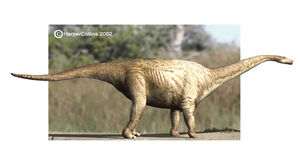
Nemegtosaurus (meaning 'Nemegt lizard') was a sauropod dinosaur from Late Cretaceous Period of what is now Mongolia. Nemegtosaurus was named after the Nemegt Basin in the Gobi Desert, where the remains — a single skull — were found. The skull resembles diplodocoids in being long and low, with pencil-shaped teeth. However, recent work has shown that Nemegtosaurus is in fact a titanosaur, closely related to animals such as Saltasaurus, Alamosaurus and Rapetosaurus.
The skull of Nemegtosaurus comes from the same beds as the titanosaur Opisthocoelicaudia, which is known from a skeleton lacking the neck and skull. Originally, the referral of Nemegtosaurus to Diplodocoidea and Opisthocoelicaudia to Camarasauridae argued that the two represented different species. The recognition that both represent advanced titanosaurians, however, raises the possibility that the two are in fact the same animal. The Nemegt Formation has been well-explored, with dozens of skeletons collected over the course of many decades, but there is nothing to suggest more than one species of sauropod in the formation, which supports the idea that Nemegtosaurus and Opisthocoelicaudia in fact are the head and body of the same animal, but skeletons preserving the head and skull have not been found yet.The type species, Nemegtosaurus mongoliensis, was first described by Nowinski in 1971. A second species, N. pachi, was described by Dong in 1977, but is a nomen dubium.
Nemegtosaurus is found in the Maastrichtian aged (66-72 Ma) Nemegt Formation, which makes it one of the last sauropods on earth. There, on a lush river delta flowing through the ancient sands of the Gobi Desert, Nemegtosaurus would have coexisted with animals like the ornithomimid Gallimimus, the alvarezsaurid Mononykus, the velociraptorine Adasaurus, and the giant, saber-clawed therizinosaur Therizinosaurus. It also lived alongside the tyrannosaur Tarbosaurus. Its size may have offered an adult some protection against Tarbosaurus, but juveniles would have been vulnerable.
Like other titanosaurs, the teeth are slender pencil-like structures that are ground down at a sharp angle to produce a chisel-like tip. The diet of Nemegtosaurus is unknown, however. There are no plant fossils from the Gobi, but during the Late Cretaceous, flowering plants became increasingly diverse, although in many environments ferns and conifers were still more common. Neither is it clear whether Nemegtosaurus browsed high in the trees or grazed on low-growing plants; related titanosaurs include both long-necked browsing forms like Rapetosaurus and short-necked forms like Bonitasaura.
Comparisons between the scleral rings of Nemegtosaurus and modern birds and reptiles suggest that it may have been cathemeral, active throughout the day at short intervals.